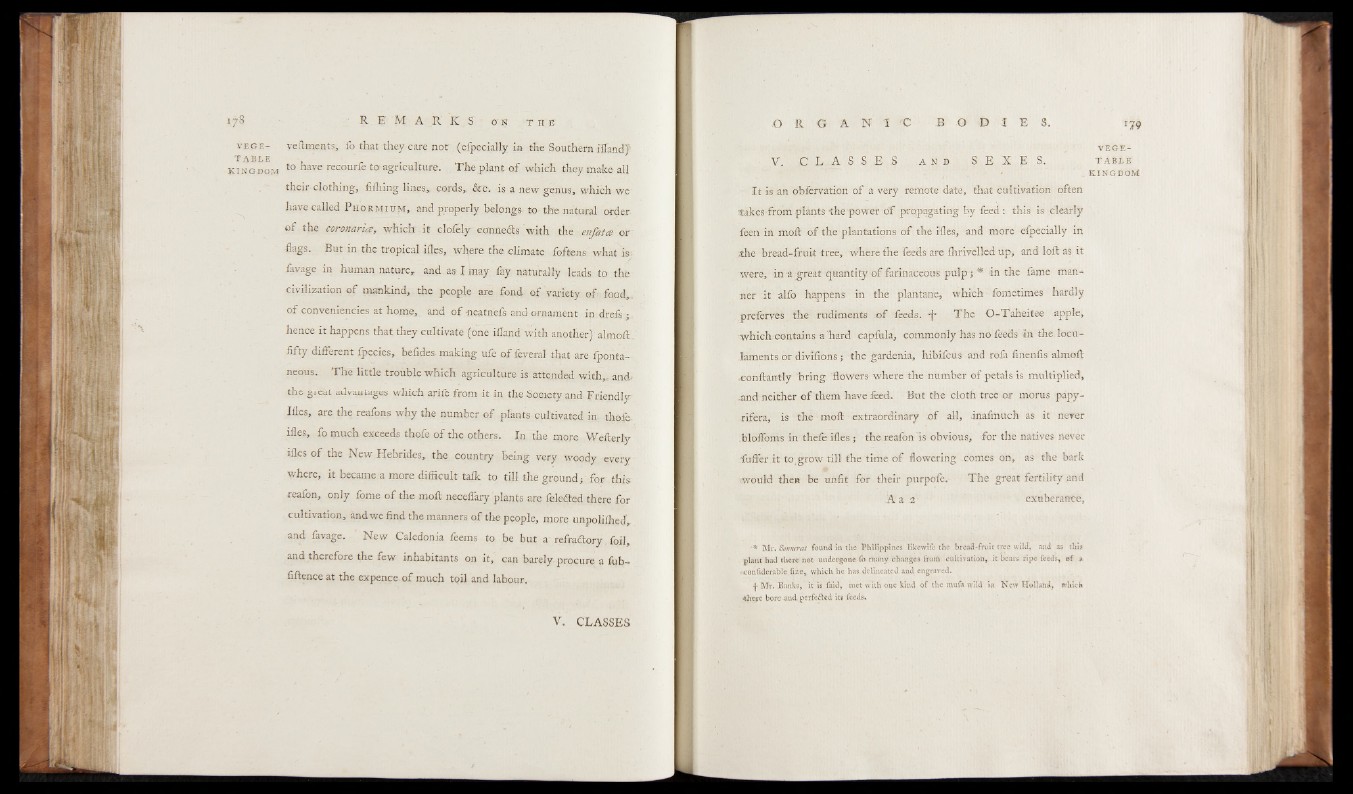
veftments, fo that they care not (efpecially in the Southern ifland)-
to have recourfe to- agriculture. Th e plant o f which they make all
their- clothing, filhing lines, cards, &c. is a new genus, which we
have called P h o r m i u m , and properly belongs, to the natural order,
o f the coronaries,, which it clolely conne&s with the enfatce or
flags. But in the tropical ifles, wpere the climate foftens what is;,
lavage in human nature, and as I lnay fay naturally leads to the
civilization o f mankind, the people are fond of variety o f food,,
o f conveniencies at home, and o f neatnefs and ornament in drefs .;,
hence it happens that they cultivate (one ifland with another)' almoft.
fifty different fpecies, befides making ufe o f feveral that are fponta-.
neous. T h e little trouble which agriculture is attended with„ and-
the great advantages which arife from it in the Society and Friendly
Ifles, are the reafons why the number o f plants cultivated in. thole,
ifles, fo much exceeds thofe o f the others. In the more Wefterly
ifles o f the New Hebrides, the country being very woody every
where, it became a more difficult talk to till the ground; for this-
reafon, only fome o f the moll neceffary plants are feledted there for
cultivation, and we find the manners of the people, more unpolilhed,
and favage. New Caledonia feems to be but a-refradlory, foil,
and therefore the few inhabitants on it, can barely procure a fub-
iiftence at the expence o f much toil and labour.
V . C LA S SE S
V . C L A S S E S a n d S E X E S . t a b l e
■ j. K I N G D O M
It is an obfervation o f a very remote date, that cultivation often
stakes from plants the power o f propagating by feed: this is clearly
feen in molt o f the plantations o f the ifles, and more efpecially in
.the bread-fruit tree, where the feeds are Ihrivelled up, and loft as it
were, in a great quantity o f farinaceous pulp ; * in the fame manner
.it alfo happens in the plantane, which fometimes hardly
preferves the rudiments o f feeds, -j* Th e O-Taheitee apple,
which contains a hard capfula, commonly has no feeds in the.locu-
.laments or divifions ; the gardenia, hibifeus and rofa fmenfis almoft
.conftantly bring flowers where the number of petals is multiplied,
.and neither o f them have feed. But the cloth tree or morus papy-
rifera, is the moft extraordinary o f all, .inafmuch as it never
bloffoms in thefe ifles; the.reafon 'is obvious, for the natives never
fuffer it to^grow till the time o f flowering comes on, as the bark
-would then be unfit for their purpofe. Th e great fertility and
A a 2 exuberance,
■ •* Mr. Somierat found in the Philippines likevvife the bread-fruit tree wild, and as this
plant had there not undergone fo many changes frorfi cultivation, it bears ripe feeds, of a
«conliderable fize, which he has delineated and engraved.
-j- Mr. Banks, it is faid, met with one kind of the mufa wild in New Holland, which
■ ■ •there bore -and. perfected its feeds.